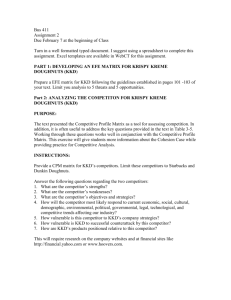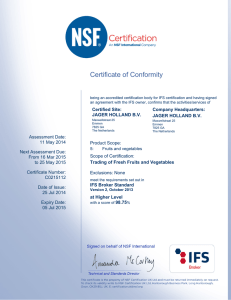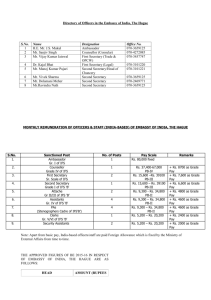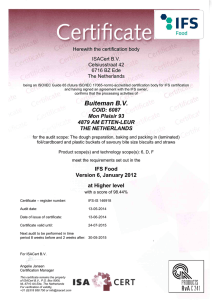A PAIR INTERFACE-SPATIAL
advertisement
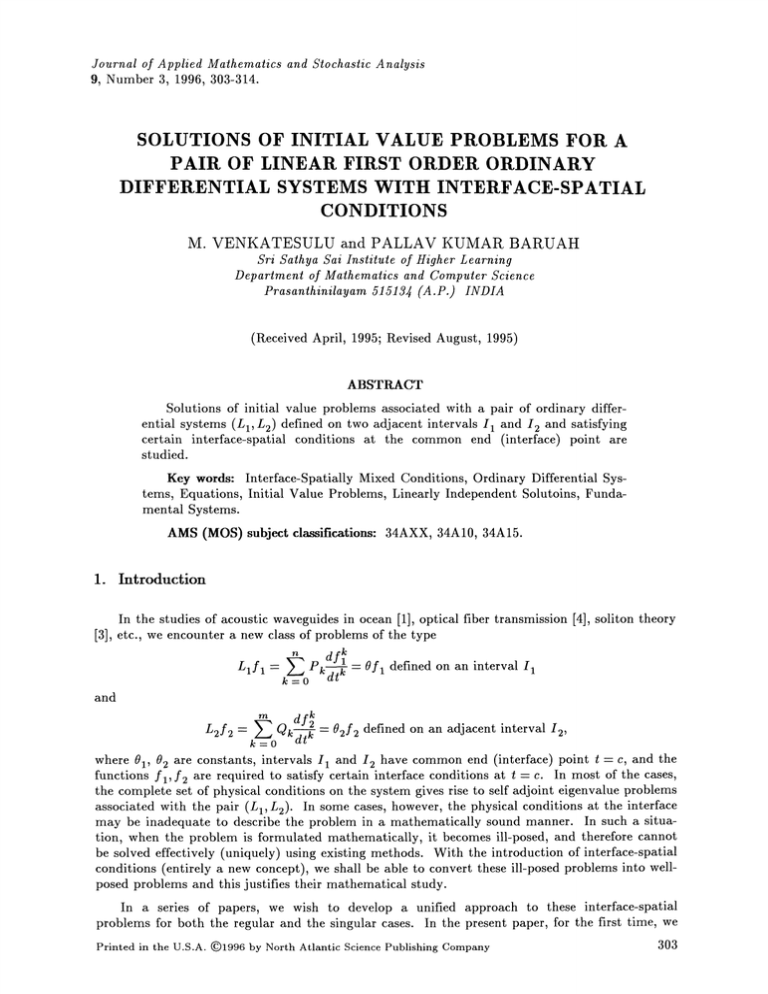
Journal of Applied Mathematics and Stochastic Analysis
9, Number 3, 1996, 303-314.
SOLUTIONS OF INITIAL VALUE PROBLEMS FOR A
PAIR OF LINEAR FIRST ORDER ORDINARY
DIFFERENTIAL SYSTEMS WITH INTERFACE-SPATIAL
CONDITIONS
M. VENKATESULU and PALLAV KUMAR BARUAH
Sri Sathya Sai Institute of Higher Learning
Department of Mathematics and Computer Science
Prasanthinilayam 51513 (A.P.) INDIA
(Received April, 1995; Revised August, 1995)
ABSTRACT
Solutions of initial value problems associated with a pair of ordinary differential systems (L1,L2) defined on two adjacent intervals 11 and 12 and satisfying
certain interface-spatial conditions at the common end (interface) point are
studied.
Key words: Interface-Spatially Mixed Conditions, Ordinary Differential Systems, Equations, Initial Value Problems, Linearly Independent Solutoins, Fundamental Systems.
AMS (MOS) subject classifications: 34AXX, 34A10, 34A15.
1. Introduction
In the studies of acoustic waveguides in ocean [1], optical fiber transmission [4], soliton theory
we encounter a new class of problems of the type
etc.,
[3],
Llf 1
dfkl
--.aPk-- Of
1
defined on an interval I 1
and
m
L2f2
X-"--,
k
df2_
2f2 defined on an adjacent interval I2,
intervals I and 12 have common end (interface) point t
v.,_aI-
0 2 are constants,
c, and the
the cases,
of
most
t
c.
at
In
conditions
to
certain
interface
are
satisfy
required
fl, f2
the complete set of physical conditions on the system gives rise to self adjoint eigenvalue problems
associated with the pair (L1,L2). In some cases, however, the physical conditions at the interface
may be inadequate to describe the problem in a mathematically sound manner. In such a situation, when the problem is formulated mathematically, it becomes ill-posed, and therefore cannot
be solved effectively (uniquely) using existing methods. With the introduction of interface-spatial
conditions (entirely a new concept), we shall be able to convert these ill-posed problems into wellposed problems and this justifies their mathematical study.
where
O1,
functions
In a series of papers, we wish to develop a unified approach to these interface-spatial
problems for both the regular and the singular cases. In the present paper, for the first time, we
303
Printed in the U.S.A. ()1996 by North Atlantic Science Publishing Company
M. VENKATESULU and PALLAV KUMAR BARUAH
304
shall study the initial value problems (IVPs) for a pair of linear first order ordinary differential
systems satisfying certain interface-spatial conditions.
Before proving the main theorems, we introduce a few notations and make some assumptions.
For any compact interval J of N and for any non-negative integer k, let Ca(J) denote the space of
/a-times continuously differentiable complex-valued functions defined on J. If I is a non-compact
interval of R, CI(I) denotes the collection of all complex-valued functions f defined on I whose
restriction f lj to any compact subinterval J of I belongs to Ck(J). Let ACk(I) denote the
space of all complex-valued functions I which have (/-1) derivatives on I, and, the (k-t) th
derivative is absolutely continuous over each compact subinterval of I. Let 11 (a, el, 12 -[c, b),
-oo_<a<c<b_< +oo, and let f(J) denote the jth derivative off. For a matrix A, let R(A)
and p(A) denote the range and rank of A. Let C n denote the complex n-dimensional space.
Let Al(t)
(A2(t))
be matrix valued functions of order n x n (m x m), whose entries belong to
C(I1)
bl(t (b2(t)) be a vector-valued function of order n x 1 (mx 1), whose entries
are integrable over every compact subinterval of I 1 (I2).
(Cd(/2)).
Let
Ca(I2)
Ck(I)
Let the functions Pk e
(/ 0,1,...,n) Q e
(k 0,1,...,m) Pn(t) 7 q} on
and Qm(t)5/: on 12. Let gl(g2) be a measurable complex-valued function defined on I 1 (I2)
which is integrable over every compact subinterval of I1(I2).
I
Without loss of generality, we assume n>_m. Let A and B be mxn and mxm matrices
with complex entries respectively, and R(A)- R(B). Consequently, p(A)- p(B)-’d( <_ m).
Let N be a subspace of R(A), and the dimension of N equals d’. Let tie Ii (i-1,2),
C column (Co, c1,... c n 1) E C n, and D column(d0, dl,... d m 1) E C m. Let Y1 column
(Yll,Yl2,"" Yln) and Y2 clumn(Y21, Y22,’" Y2m)"
Consider the following interface-spatially mixed pair of linear first order ordinary
differential systems:
Yi AI(t)Y1 -t-bl(t),
Y’2 A2(t)Y2 + b2(t),
AYI(C)- BY2(c) E N.
(1)
(2)
(3)
YI(C)=C
(4)
Y2(c)
(5)
tE
11,
E 12,
Also, consider the initial conditions
and
D.
We call problems (1)-(3) and (4)((5)) the interface-spatially mixed initial value problems
(IFSIVP) (I)((II)).
Consider the following interface-spatially mixed pair of linear ordinary differential equations (of orders n and m):
d2fl
E Pkdt2
n
Llfl
I 1,
(6)
t E I 2,
(7)
gl, t E
k=0
Qk
L2f 2
k
=o
d
dt
Aft(c)- B f 2(c
g2,
E N,
where
71 -clumn(fl,fl),...,fn-l),
IVPs ]:or
a Pair
of ODS with IFS
Conditions
305
and
72
column
1)).
(f2, fl),..., fm
Also consider the initial conditions
fJ)(tl)
fJ)(t2)
0,1,...,n- 1),
(9)
dj (j O, 1,...,m-1).
(10)
cj
(j
We call problems (6)-(8) and (9) ((10))the interface-spatially mixed initial value problems
(IFSIVP) (I’) ((II’)).
Definition 1: We call a pair of vector-valued functions
interface-spatially mixed (IFS) solution of (1)-(2)if
(i)
Y.j E ACI(I1) (j- 1,...,n),
(ii) Y1 satisfies equation (1) for almost all t E I1,
(Y1,Y2),
defined on
11 x 12,
an
Definition 2: We call a pair of complex-valued functions (fl,f2), defined on
interface-spatially mixed (IFS) solution of (6)-(7) if
e Acn(I1) and satisfies equation (6) for almost all t G I,
(i)
(ii) I2 6 AC’(I2) and satisfies equation (7) for almost all t e 12
and
(iii) the pair (f, f)satisfies relation (8).
11 x 12,
an
(iii)
(iv)
and
Y2j e ACI(I2) (j- 1,...,m),
Y2 satisfies equation (2) for almost all t 12,
the pair
(Y, Y2)satisfies relation (3).
I
Definition 3: We call a pair of vector-valued functions
interface-spatially mixed solution of IFSIVP(I) ((II)) if
(i)
(Yl, Y2)is an IFS solution of (1)-(2)
and
(ii) YI(Y2) satisfies condition (4) ((5)).
Definition 4: We call a pair of complex-valued functions
interface-spatially mixed solution of IFSIVP(I’) ((II’)) if
(i)
(/1, I2)is a IFS solution of (6)-(7)
and
(ii) (/1, Ie) satisfies condition (9) ((10)).
(Y1,Y2),
defined on
11 x 12,
an
(fl, f2),
defined on
11 x 12,
an
(YI, Y12),...,(Ypl, Yp2)
are
Definition 5: We say that a collection of non-trivial pairs
linearly independent if for any set of scalars Cl,...,cp,
p
E ci(Yil’ Yi2)
(0, O)
i--0
implies that c 1
c 2 =...
Cp
O.
(fll, f12),’", (fpl, fp2)"
IFSIVP(I) ((II)), we mean a set
Similarly, we define the linear independency of a collection of pairs
of
Definition 6: By an IFS fundamental system for the
linearly independent IFS solutions of IFSIVP(I) ((II)) which span the IFS solution space of
IFSIVP(I) ((II)).
Similarly, we define a fundamental system
for the IFSIVP(I’) ((II’)).
M. VENKATESULU and PALLAV KUMAR BARUAH
306
2. Main Theorems
Theorem 1: (a) If either bl(t 5 0, b2(t 5 O, or C is a nonzero vector, then the IFSVP(I)
has an IFCo fundamental system consisting of "m- d + d’+ 1" linearly independent IFS solutions
of IFSIVP(I). If bl(t --0, b2(t _= 0, and C is a zero vector, then the IFSIVP(I) has an
fundamental system consisting of "m- d + d’" linearly independent IFS solutions of IFSIVP(I).
(b) If either bl(t 5 O, b2(t 5 0, or D is a nonzero vector, then the IFSIVP(II) has a
fundamental system consisting of "n d + d’ + 1" linearly independent IFS solutions of
IFSIVP(II). If bl(t _= 0, b2(t 0, and D is a zero vector, then the IFSIVP(II) has an IFS
fundamental system consisting of "n- d + d’" linearly independent IFS solutions of IFSIVP(II).
Proof: Since the components of bl(t are measurable complex-valued functions integrable on
Theorem 2.1 [2], there exists a unique vector-valued function (t)=column(l(t),
by
11
2(t),..., en(t)) defined on 11 with ej E ACI(I1) such that
’(t) A l(t)(t) + b l(t), t E I1,
(tl) C.
Let ,c)= r]. Since R(A)- R(B), there exists a vector flE C m such that At] B
If
Ar] 5/= 0, flu is a nonzero vector, and if A 0, then we take 0 to be zero vector. Since p(B) d,
there exist (m-d) linearly independent vectors t31,/32,...,m-dE C m which are solutions of
B/? 0. Clearly, /3 0 + 31,...,/0 +/3m-d are (m- d + 1) or (m- d) linearly independent
solutions of A B, affected by Ar] 5/= 0 or A 0.
Also, since the components of b2(t are measurable complex-valued functions integrable on I2,
there exists a unique vector-valued function o(t)=column (01(t),...,on(t))defined on
.
,
12 with oj(t)E ACI(I2)such that
’(t)
A2(t)o(t + b2(t),
tE
12,
#0.
Let
i(t)-column(il(t),...,in(t)),
defined on
vector-valued function such that
12
with
ij E ACI(I2),
be the unique
i(t) A2(t)i(t), t E 12,
i(c )_/i, i-1,...,m-d.
Clearly, 1,-",
independent.
em-
Choose a basis
Since c
Ct
d are
1
linearly independent and
m-d+ds
21 -.,m-d+d’ are linearly independent.
Again, let
i(t),
Clearly, 1,’",
em
em-
are
also linearly independent.
I2, be a unique vector-valued function such
i(t) A2(t)i(t), E 12,
i(c) --/i (i rn d + 1,..., rn d + d’).
defined on
d
d are
also linearly
,..., ct d’ for N, and let fl- /3rn-d + be a solution of
--Bm-d+i=o (i- l,...,d’).
linearly independent
are
if/30 5 0, then.e0,...
+ d’
are linearly independent.
Now, define
(Y01, Y02)
(, 0),
that
In fact,
IVPs for
a Pair
of ODS with IFS
Conditions
307
(Yil,Yi2)-(,o+i) (i-1,...,m-d+d’).
Clearly, each pair (Yil,Yi2) (i-0,1,...,m-d+d’)is an IFS solution of (1)-(2). Moreover, if
bl(t 0, b2(t 0, or C 0, then the pair (, o) is nontrivial.
Claim: For bl(t )0, b 20 or C=0, {(Yil, Yi2),i=O,...,m-d+d’} is an IFS fundamental system for the IFSIVP(I).
m-d +d
Let
ai(Yil, Yi2) (0, 0), where ais are scalars. Then
=0
m-d+d
E
m-d+d
aiYil
0
E
and
z=O
Consequently, we get
(11)
O.
aiYi2
i=0
m-d +d
E
ai[A(c)- B(o(C) + i(c))] + ao(A(c
Bo(C)) 0,
i---1
m -d
E + ai(-Bi(c))--O’
i.e.,
m- d
m-d +d
E
O, which implies that
aio
0 (i
a
m
d + 1,..., m
d + d’).
i-’m-d+l
Hence, relation (11) becomes
m-d
E ai
m-d
0 and
i=0
Again, from relation
(12),
we
E ai(O + i) + Aoo
(12)
O.
i=1
get
E hi)Co(C)-4- E aii(c) O,
(E ai )0+ E ai i- O.
i=0
i-1
i=0
o
(13)
i=1
O, then 0, ill,..., tim d, are linearly independent and hence a 0 (i O, 1,..., m d). If
/-0, then relation (13) gives ai-O (i-1,...,m-d)and from relation (12) we get
ao(, o) (0, 0), which implies that ao 0. Thus, (Yil, Yi2) (i O, 1,..., m d + d’) are linear-
If
ly independent.
"
Now, let (Y1, Y2) be any solution of the IFSIVP(I). We note that Y1
Case (i): Suppose that AYe(c)- BY2(c
O. Furthermore, since A(c)- Bo(C
get
B(Y2(c)-o(C))-0,
which implies that
Therefore, there exist constants
a
Y2(c)-0(c)
0, we
belongs to the null space of B.
(i- 1,..., m- d) such that
m-d
E ai i’
0 + E ai i (1- E ai ) + E ai ( +
(1 E ai)o(C) + E ai(o(C)-t(1- E ai)Yo2(C) + E aiYi2(c)"
Y2 (c) 0 (c)
y2(c
m-d
m-d
m-d
i=1
i=1
i=1
i--1
i=1
i=1
i=1
M. VENKATESULU and PALLAV KUMAR BARUAH
308
Thus, by the uniqueness of the solution of IVPs for a system of ordinary differential equations,
have
m-d
m-d
E
(1
(YI’ Y2)
we
ai)(Yol’ Yo2) +
E ai(Yil’ Yi2)"
i=1
i=1
d
Case (ii): Suppose that AYI(C
Define a pair (K1,K2) by
BY2(c
(1
are scalars.
m-d +d
m-d +d
(K1,K2)
+ m-dCi, where ais
a
i=1
E
ai)(Yol’Y02) -’[-
m-d-t-1
E + ai(Yil’Yi2)"
m-d
(14)
l
(K1,K2) is an IFS solution of IFSIVP(I). Consequently, we get
B(r2(c K2(c)) 0.
Then
Therefore, there exist scalars a (i- 1,..., m- d) such that
m-d
E ai/3i’
Y2 (c) --K2(c)+ E ai i
K2(c)- (E ai )t30 + E ai (0 + fli)
K2(c)- (E ai)o(C) + E ai(o(C) + g2i (c))
Y2 (c) K2(c)
i=1
i.e.,
m-d
i=1
m-d
m-d
i=1
i=1
m-d
m-d
i=1
i=1
(15)
Thus,
E ai(Yol’Yo2)-t- E ai(Yil’Yi2)
=(1- E ai)(Yol,Yo2)+ E ai(Yil,Yi2).
(YI’Y2) -(KI’K2)-
i=1
i=1
m-d +d
m-d +d
i=1
i=1
Hence, the claim is proved. If bl(t -0, b2(t -0, and C- 0, then (,0) is a trivial pair and
the pairs (Yi,Yi2) (i- 1,...,m-d +d’) form an IFS fundamental system for the IFSIVP(I).
This completes the proof of part
(a). Part (b)can proved similarly.
Theorem 2: There exist exactly "n + rn
d + d’ linearly independent
Yi AI(t)Y1,
(IFS)
tE
11,
Y’2- A2(t)Y2, t e 12,
solutions
of
(16)
(17)
satisfying the interface-spatial conditions
AYI(C
BY2(c e N.
(18)
Since p(A)-p(B)-’d, there exists a basis {r]l,...,r] n} for C n such that
{r]l,...,/] n-d} forms a basis for the null-space of A, and a basis {/l,...,/m} for C TM such that
{/d + 1,..., /3 TM} forms a basis for the null space of B.
Proof:
Let
il (whose components belong to AC(I1)) be the unique solution of
IVPs for
a Pair
of ODS with IFS
Y’I AI(t)Y1,
R(A)- R(B),
309
I,
tE
]i (i- 1,...,n).
Yl(C
Since
Conditions
for each i-n-d/ 1,...,n, there exist scalars
that
0j
(j
1,...,d)
such
d
Aqi-
E O B/3j"
j=l
---
Let
Yi2 (with components belonging to AC(I2) be the unique solution of
Y’2- A2(t)Y2, t 12,
Y2(c )_B3i-n+d (i-n+l,...,n+-d).
Let
(1,...,ad’} be a basis for N and choose i G Cm such that
Let
(- 1,...,’).
i (with components belonging to AC(I2)) be the unique solution of
Y- A(t)Y,
Y(c)
Define the pairs
+
(i
n
I,
t
+ m-d + 1,..., n + m-d +d’).
(Yil,0) (i-l,...,n-d),
a + 1,..., ),
(1, ) (i
(O, Yi2) (i n + l,. n 4- m d + d’).
(Yil,Yi2)
(Y/I, Yi2) is a nontrival IFS solution of (16)-(18).
Claim: (Yix, Yi2) (i 1,...,n + m-d +d’) form an IFS fundamental system for the IFS
solutions of (16)-(18).
First, we shall show that the pairs (Yil, Y i2) are linearly independent. To this end, let
Clearly each pair
n+m-d+d
E
(0, 0),
ai(ril, Yi)
where ais are scalars.
i=1
Then,
n
n
Eaiil
--0 and
i=1
+m
d
E
+ d’
aii2--0.
(19)
i=n-d+l
Since Nil(C) (i-1,...,n +m-d +d’) are linearly independent, from the first equation of
relation (19) we get a
0 (i 1,..., n). Consequently, the second equation reduces to
n+m-d+d
E
(20)
aiYi2-O"
i=n+l
Evaluating the above expression at t-c and then applying the matrix B to the resulting
expression, we get
n+m-d+d
aio
n- m
+d
O,
i=n+m-d+l
which implies that a
O, for
n
+m
d + 1,..., n + m
d + d’. Thus, relation
(20)
reduces to
M. VENKATESULU and PALLAV KUMAR BARUAH
310
_,
n+m-d
i--n+l
aiYi2
be easily
0, and since Yi2(c) (i
verified),
n
+ 1,..., n + rn- d) are linearly independent (this fact can
it follows that
(i-n+l,...,n+m-d).
independency of (Yil, Yi2)s.
a i-O
This proves the linear
Next, let (Y1,Y2) be any IFS solution of (16)-(18). Choose scalars
a
(i- 1,...,n) such that
n
E ai7i"
YI(C)
(21)
i=1
AYI(C BY2(c
n
(K1,K2)- ai(YilYi2 ).
Case (1): Suppose that
Define the pair
’
i--1
n
Then Kl(C)iimplies that
O.
Hence, Y1-Ki and B(Y2(c)-K2(c))-O which
aiYil(C)-Yl(C).
1
n+m-d
Y2 (c) K2(c)+ E
ai
i-n +d for some scalars ais
i=n+l
n+m-d
Y2(c)
K2(c)+
E
aiYi2(c)"
i’-n+l
n-l-m-d
Thus,
-
i=n+l
n+m-d
i=1
Case (2): Suppose that
A(YI(C -BY2(c
are scalars.
nTm-dTd
ai(Yia,Yi2)
(H1,H2)E
i=n+m-d+l
A(HI(C Yl(c))- B(H2(c Y2(c))
Define
Then
nTm-d
(Y1 HI, Y2- H2)
E
n
nt- m
d .q- d
aioi
i=nTrn-dT1
n
m
-b
d,
where ais
0, and therefore, by case (1),
ai(Yil, Yi2) for some scalars ais.
i=1
Thus,
nTm-d
(YI’Y2)
(Hi’H2)+
E
ai(Yil’Yi2)
i-1
nTm-dTd
E
ai(ril, Yi2)"
i=1
This completes the proof.
Remark 1: The assumption d’= d yields that there are no explicit boundary conditions at
the interface point.
If d’
0, then the interface-spatial condition becomes
AYI(c)-BY2(c)-O,
which is generally called the
interface
condition.
Since higher order ordinary differential equations can be converted into a system of first order
IVPs for
a Pair
of ODS with IFS
Conditions
equations, Theorems 1 and 2 yield the following results for the pair
311
(L1,L2):
Theorem 3: (a) If either gl # O, 92 O, or Co, Cl,...,Cn_ 1 are not all zeros, then the
IFSIVP(I’) has a fundamental system consisting of "m-d +d’+ 1" linearly independent
solutions of IFSIVP(I’). If gl =- O, g2 =- O, and Co, Cl,...,Cn_ 1 are all zeros, then the IFSIVP(I’)
has a IFS fundamental system consisting of "m-d+d’" linearly independent solutions of
IFSIVP(I’).
(b) If either 91 7 O, 92 O, or do, dl,...,d n_ 1 are not all zeros, then the IFSI’VP(II’) has a
IFS fundamental system consisting of "n-d +d’+ 1" linearly independent IFS solutions of
IFSIVP(II’). If 91 =- O, g2 O, and do, dl,...,dn_ 1 are all zeros, then the IFSIVP(II’) has an
IFS fundamental system consisting of "n-d+d’" linearly independent IFS solutions of
IFSIVP(II’).
Theorem 4: There exist exactly "n + m-d + d’" linearly independent (IFS) solutions of
Llf 1=0, t G11
L2f 2=0, tEI 2,
satisfying the interface-spatial conditions
A f l(c
Remark 4: For d’
B f 2(c G N.
d, Theorems 3 and 4 reduce to Theorems 1 and 4 of [6].
For d’= 0, Theorems 3 and 4 reduce to Theorems 3 and 6 of [6].
For d’ 0 as well as for the (m n) matrix A given by
mth column
A-
0 ...0
0
0
0
1... 0
0
0
0
0
0
and B equal to the
(mx m)
T
1
0
1
identity matrix, Theorems 3 and 4 reduce to Theorems 2 and 5 of
[6].
3. Physical Examples
Example 1 Acoustic waveguides in ocean [1]: The following problem is encountered in the
study of acoustic waves in the ocean consisting of two layers: an outer layer of finite depth and
an inner layer of infinite depth:
d2fl2 + kf 1 AI 1
dt
Ll f l
L2f 2
d2 f 2
dt 2
+ kf 2
A f 2,
< t < d1
(22)
dl < < t <_ + c,
(23)
0
together with the end point conditions given by
1‘
fl (0) --0 t It f ’-
and the interface conditions given by
0,
(24)
M. VENKATESULU and PALLAV KUMAR BARUAH
312
_-
1/P2f1)(d1).
fl(dl)- f2(dl), 1/Plf(dl)
(25)
Here ill, f12 are constant densities of the two layers, kl,k 2 are the constants which depend upon
the frequency constant and the constant sound velocities Cl, c 2 of the two layers, respectively, is
an unknown constant, d I denotes the depth of the outer layer, and fl,f2 stand for the depth
eigenfunctions.
In this example, the interface conditions at t- d I of the two layers can be written in the
matrix form
0
A_(
Hence,
fl)(dl)
1/p I
fl)(dl)
1/p I
0
)
/ ), g-(
o
1
rn-n-d-2andd’-0.
o / ,rankA-rankB-2,
by Theorem 3 and Remark 2, there exist a unique IFS solution for any IFSIVP
associated with (22)-(23) and (25). Also, By Theorem 4 and Remark 2, there exist exactly two
linearly independent IFS solutions of problems (22)-(23) and (25).
Here
1
o
o
Example 2 Optical fiber transmission
encounter the following problem"
Llf I
L2f 2
d2fl2 + lit
dt
d2 f 2
dt 2
_4_
l/t
[4]: In the study of wave optics of step index fiber,
+ (rlk -u2/ t2)f 1
+ (ri2k u2/t2)f 2
fl2fl
2
f2,
we
0
<t<a
(26)
a
_< t < co,
(27)
together with the interface conditions at t- a, given by
It
t---0
Ifl(t) <
-4-,ttlf2(t)
o.
(29)
Here r]l and q2 are the refractive indices of the core and cladding, respectively, is the wave propagation constant, u is an integer k 0 w/c, c is the prorogation velocity and w is the wave frequency and fl and f2 are the field (electromagnetic) distributions of core and cladding, respectively.
In this example, relation (28) gives continuity conditions at t a. Here A and B are the
2 2 identity matrices, n rn d 2 and d’= 0. Hence, by Theorem 3 and Remark 2, there
exists a unique IFS solution for IFSIVP associated with (26)-(28). Also, by Theorem 4 and
Remark 2, there exist exactly two linearly independent IFS (continuous) solutions of (26)-(28).
Example 3 One-dimensional scattering in quantum theorem [3]: In quantum theory, the
one-dimensional time-independent scattering problem with the delta function scattering potential
is represented by the problem:
Ll f l
L2f2--
d2fl-4-k2fl-O,
dt
2
d2f2dt + (/c2
2
"o)f2
-cx3<t<0,
(30)
O, 0 _< <
(31)
+ cx,
together with the interface conditions given by
fl(O)- f2(O)--0,
(32)
IVPs for
of ODS with IFS
a Pair
fl)(0) fl)(0)
313
Conditions
P0fl (0),
(33)
where k 2- 2mE/h 2, v o is a constant, and the functions fl and f2 are associated with the flux
density of the particle of the two regions, respectively. Here, m denotes the mass of the particle,
E denotes its total energy, and h denotes the Planck constant divided by 277. In this example,
the interface conditions at t 0 of the two regions can be written in the matrix form
’o
fl)(o)
1
0
fl)(o)
1
Here
(1 o)
1
Uo
1
0
0
1
rankA=rankB=2, rn=n=d=2, andd’=0.
),
Hence, by Theorem 3 and Remark 2, there exists a unique IFS solution of any IFSIVP
(3o)-(33). Aso, by Theorem 4 and Remark 2, there exist exactly two linearly
associated with
independent IFS solutions of
(30)-(33).
Example 4: In this illustrative example, consider the following problem:
Ll f l
d2fl.-kf1-0,
dt 2
d2
f2+kf2_O,
L2f2_ dt 2
a<_t <_c,
(34)
c<t<b
(35)
together with interface condition
(36)
fl(c) f2(c)
and the end point conditions
fl(a)
(37)
f2(b),
0
where k I and k 2 are constants. Problems (34)-(37) can be thought of as the transverse vibrations
of a string stretched between a and b, fixed at a and b, with different uniform linear densities (in
the portion) between a and c and between c and b, and plucked at the point t c.
In this example, there is only one condition at the interface (i.e., the continuity
and no definite relation between the derivatives is available. Therefore, we may take
fl)(c)- fl)(c)
We note that relation (38) is not at all
and
(38)
o, c
condition),
e N,
a restriction on derivatives.
(38)
Consequently, relation
(36)
eN,
(39)
can be written as
fl)(c)
0 1
fl)(c)
Here, A=B=the (2x2) identity matrix, n m d 2, and d’= 1. Therefore, by
Theorem 3, there exist one or two linearly independent IFS solutions of the IFSIVP associated
with problems (34)-(36) depending on whether the initial data is zero or nonzero. Also, by
Theorem 4, there exist three linearly independent IFS solutions of problems (34)-(36).
M. VENKATESULU and PALLAV KUMAR BARUAH
314
Remark 3: The results of this paper are used in studying the deficiency indices and selfadjoint boundary value problems associated with (L1,L2) satisfying interface-spatial conditions
which we shall establish elsewhere.
Acknowledgement
The authors dedicate the work to the chancellor of the Institute Bhagawan Sri Sathya Sai
Baba.
References
[1]
[2]
[4]
Boyles, C.A., Acoustic Waveguides, Applications to Oceanic Sciences, Wiley, New York
1984.
Brauer, F. and Nohel, J.A., The Qualitative Theory of Differential Equations- An Introduction, Benjamin, New York 1969.
Lamb, Jr., G.L., Elements of Cooliton Theory, Wiley, New York 1980.
Noda, K., Optical Fiber Transmission, Studies in Telecommunication 6 (ed. by K. Noda),
North-Holland, Amsterdam 1986.
Venkatesulu, M. and Bhaskar, T.G., Self-adjoint boundary value problems associated with
a pair of mixed linear ordinary differential equations, J. Math. Anal. Appl. 144:2 (1989),
322-341.
Venkatesulu, M. and Bhaskar, T.G., Solutions of initial value problems associated with a
pair of mixed linear ordinary differential equations, J. Math. Anal. Appl. 148:1 (1990), 6378.
